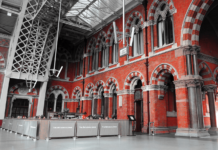Each restoration and conservation of a historic building must be subordinated to the general idea of preserving the architectural monument and its inherent unique features, which may relate to construction, construction techniques or external appearance and historical significance. The joint task of architects, historians and practitioners is to determine to what extent each element is preserved and to what extent it is recreated. Is it necessary to preserve, preventing destruction, or make anew using restoration techniques and materials of the past, or perhaps to replace them with modern products?
The restoration of historic buildings involves a selection of proven conservation and restoration techniques:
Cleaning
Due to the large area of its inner surface, the layer of pollution is an excellent absorbent for moisture and particles of harmful substances. As a rule, they make the destruction of the material faster, even if it is not visible from the outside at first. So there is a need for cleaning:
- Eliminate risk factors such as the salt build-up and slow drying
- Preparation of the base for subsequent conservation work, restoration of capillary absorbency
- Removal of contaminations that ruins the appearance.
Desalination
The process of removing salts from the surface of a structure, which helps to wash out salts from the body of the structure in the treated areas. Binding of salts in the body of the structure and thus preventing further salt formation on the surface.
Stone strengthening
Weathering of a mineral building material is always accompanied by a weakening of its structure. This weakening is caused by the expansion of the original pore space, and sometimes by the loss of the original binder. The main task of strengthening is the targeted filling of new pore spaces formed as a result of weathering. This is done by introducing an additional binder identical to the natural one. In addition, clay minerals are neutralized to reduce their expansion.
Cleaning and filling joints
Joints perform various functions in a building structure, to meet the requirements, they must have a wide variety of properties. This applies not only to visual but also to physical, mechanical and especially moisture-technical parameters. The impeccable condition of the joints is the guarantee of the resistance of the facade to precipitation. If moisture gets inside, it leads to an increased load from frost and a decrease in thermal protection – both should not be allowed. In addition, facade materials can begin to deteriorate from accumulated moisture.
Hydrophobization
In addition to the main function – protection from moisture, hydrophobizators significantly improve other characteristics of surfaces. Due to the application of the compositions, the surfaces become less prone to contamination with dust and soot, which is especially important in a megalopolis. The use of impregnations reduces the need for paints and varnishes, preserves the original appearance of the object, eliminates the destructive effect of the external environment and reduces the risk of mould.
Filling cracks and consolidating masonry
In most cases, voids and cracks inside the masonry reduce its load-bearing capacity. Filling such voids is one of the necessary measures when restoring masonry. The mortars used for filling and pressing should be selected based primarily on the strength, water absorption capacity and compatibility of the binders.
Antibiotic treatment
A treatment process to kill and prevent the growth of fungi and microorganisms on stone, concrete and plaster surfaces.
Additional layout, restoration of the stone surface
To restore the surface of the stone, the method of filling the loss with compositions similar to the original material is used. At the same time, the surface of the stone is restored to a depth of 3-5 cm. In the case of deeper damage, stone carving is used.
Plaster
Previously, plaster was used as weather protection, which also made it possible to hide different materials and create a uniform appearance. Later, plasters began to be used due to the possibility of their modification and numerous applications. Restoration of plaster is a process of partial replacement and replenishment of damage with compositions similar to historical ones.
Architectural decor
The work includes modelling, mould making and moulding of stucco decoration elements. The reconstruction of the plaster decor is carried out by historical compositions according to templates taken from the historical decor.
The restoration, conservation and adaptation of historic buildings to modern use require a careful approach and the right choice of methods and techniques.
Our specialists are always ready to offer suitable technological solutions for the restoration and conservation of historic buildings.



